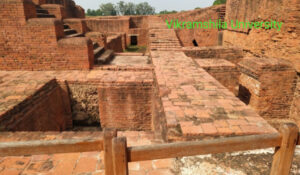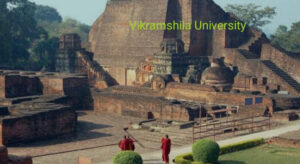When we think of ancient Indian education, institutions like Nalanda and Takshashila often come to mind. These universities were not only centers of learning but also symbols of India’s rich intellectual heritage. However, Vikramshila University, another significant seat of learning, often remains in the shadows. Established during the Pala dynasty, Vikramshila University was a major center for Buddhist studies and played a crucial role in the spread of Buddhism across Asia. In this blog post, we will delve into the history, academic excellence, architectural grandeur, and the enduring legacy of Vikramshila University.

1. The Foundation of Vikramshila University
Vikramshila University was established in the late 8th or early 9th century by King Dharmapala of the Pala dynasty. The Palas were great patrons of Buddhism, and King Dharmapala founded Vikramshila with the vision of creating a hub for Buddhist learning. At the time, Nalanda University was already thriving, but King Dharmapala recognized the need for another institution to further the study and practice of Buddhism, especially the Vajrayana tradition.
Vikramshila was strategically located on the banks of the Ganges River, in what is now Bhagalpur, Bihar. The university was designed to serve as a major center for the study of Buddhist philosophy, as well as other subjects like grammar, logic, a
nd metaphysics. Over time, it grew to become one of the most important educational institutions in India, attracting scholars from across the country and beyond.
2. Architectural Grandeur of Vikramshila
The architectural design of Vikramshila University was nothing short of magnificent. The university campus was sprawling, covering a vast area, and was meticulously planned. It had five main entrances, each guarded by statues of Mahakala, a Buddhist deity. These entrances symbolized the university’s openness to knowledge from all directions.
At the heart of the campus was the central temple, known for its intricate carvings and detailed iconography, which depicted various scenes from Buddhist scriptures. Surrounding the temple were numerous meditation halls, residential quarters for monks, and lecture halls where scholars would engage in rigorous debates and discussions.
The architectural style of Vikramshila was a blend of traditional Indian design and Buddhist influences, similar to what can be seen in the ruins of Nalanda. The layout and construction of the buildings reflected the university’s spiritual and intellectual pursuits, creating an environment conducive to learning and contemplation.

3. Academic Excellence at Vikramshila
Vikramshila University was renowned for its academic rigor and excellence. The curriculum was diverse, covering a wide range of subjects. While the primary focus was on Buddhist studies, particularly the Vajrayana tradition, students also studied subjects like philosophy, grammar, logic, metaphysics, and Tantric Buddhism.
One of the most notable scholars associated with Vikramshila was Atisha Dipankara, a revered Buddhist teacher who later played a crucial role in the revival of Buddhism in Tibet. Atisha’s association with Vikramshila underscored the university’s importance as a center of Buddhist learning.
The university had a structured educational system, with different levels of study, similar to modern-day degrees. Students had to pass rigorous examinations to move from one level to the next, ensuring that only the most dedicated and knowledgeable individuals advanced.
4. Vikramshila’s Contribution to Buddhism
Vikramshila University was not just an academic institution; it was also a spiritual center that contributed significantly to the spread of Buddhism. The university was a major center for the study of Vajrayana Buddhism, a branch of Buddhism that incorporates Tantric practices. The monks and scholars trained at Vikramshila played a vital role in spreading Vajrayana teachings across India, Nepal, Tibet, and other parts of Asia.
Monastic life at Vikramshila was disciplined and focused on spiritual development. Monks engaged in meditation, rituals, and scholarly activities, all aimed at deepening their understanding of Buddhist teachings. The university produced numerous scholars who traveled far and wide, spreading the teachings of Buddhism and establishing monastic centers in other regions.

5.The Decline and Destruction of Vikramshila
The glory of Vikramshila University, however, was not to last. In the late 12th century, the university faced the onslaught of Bakhtiyar Khilji, a Turkish general who led the Muslim conquest of Bihar and Bengal. Khilji’s invasion was marked by the destruction of numerous temples, monasteries, and educational institutions, including Vikramshila.
The university was plundered, its libraries burned, and its monks massacred or forced to flee. The destruction of Vikramshila was a significant blow to the Indian educational system and marked the beginning of a period of decline in Buddhist learning in the region.
6.Rediscovery and Preservation Efforts
For centuries, Vikramshila remained forgotten, its ruins buried under layers of history. It was not until the 19th century that the site was rediscovered by British archaeologists. Excavations revealed the remains of the once-grand university, including the central temple, stupas, and other structures.
Today, efforts are being made to preserve and restore the ruins of Vikramshila. The site is now a protected monument, and the Indian government, along with various heritage organizations, is working to ensure that this important piece of India’s history is not lost to time. The preservation of Vikramshila is a testament to the enduring legacy of ancient Indian education and its contributions to global knowledge.
7.Vikramshila University in Modern Times
In modern times, Vikramshila has become a popular tourist destination, attracting visitors who are eager to learn about India’s rich educational heritage. The site offers a glimpse into the past, showcasing the architectural and intellectual achievements of ancient India. For many, visiting Vikramshila is not just a journey through history, but also an opportunity to reflect on the importance of education and the pursuit of knowledge.
The cultural impact of Vikramshila University continues to resonate in contemporary India. It serves as a reminder of the country’s glorious past as a center of learning and as an inspiration for the future. The story of Vikramshila is one of resilience, a testament to the enduring power of knowledge and the human spirit.
Conclusion:
Vikramshila University stands as a symbol of India’s rich educational and cultural heritage. Although it may not be as well-known as Nalanda, its contributions to the world of learning and Buddhism are no less significant. As we continue to uncover and preserve the ruins of Vikramshila, we not only honor the past but also keep alive the legacy of an institution that once illuminated the minds of scholars and monks from across the world. Exploring the history of Vikramshila University is a journey into the heart of ancient Indian education, a reminder of the timeless value of knowledge, and an invitation to delve deeper into the treasures of India’s past.
FAQs:
1.Who destroyed Vikramshila university?
2.Who built Nalanda and Vikramshila university?
3.Who established Vikramshila university in Magadha?
4.In which state is Vikramshila university?
5.Vikramshila University made by
6.Vikramshila university in which district
7.Vikramshila University destroyed by
8.Vikramshila University in Hindi
9.Vikramshila University UPSC
10.Nalanda and Vikramshila University

